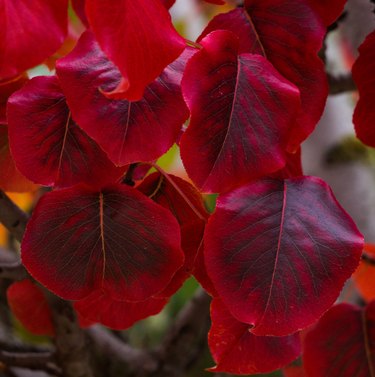
The Schubert chokecherry is a beautiful reddish-purple-leaved selection of chokecherry (Prunus virginiana 'Schubert'). The cultivar Schubert was introduced in the 1940s as an ornamental tree for garden settings.
Don't be alarmed in spring when the leaves emerge green. This cultivar's leaves gradually attain the reddish-purple foliage hues as the leaves mature heading into late spring.
Video of the Day
Video of the Day
About Schubert Chokecherry
Chokecherries are native to a wide expanse of central North America, and the fruits are edible and usually made into preserves, sauces or wine. Tolerant of both alkaline and clay soils, the Schubert chokecherry matures 20 to 30 feet tall and 15 to 22 feet wide. It grows and looks its best in cool-summer regions across U.S. Department of Agriculture (USDA) plant hardiness zones 2 through 7.
Do not confuse the Schubert chokecherry with the cultivar Canada Red, which bears darker burgundy-purple leaves but was formed as a mutation of a Schubert chokecherry tree.
Planting a Schubert Chokecherry
Plant the Schubert chokecherry tree on fertile soil that does not flood or remain soggy after rains or irrigation. A site that receives at least eight hours of direct sunlight a day ensures the best habit and intensity of leaf coloration and production of flowers and fruits. Use a garden shovel to make the planting hole as deep as the tree's root ball but two to three times as wide.
Water the tree once planted and keep the soil moist for the first year after planting in the landscape. Supplement natural rainfall to ensure that the original root ball doesn't dry out as the roots eventually spread out into the soil. Irrigation during a drought is essential.
Cover the soil around the trunk of the Schubert chokecherry with a 3- to 4-inch layer of organic mulch. Extend the mulch 2 to 3 feet beyond the farthest reach of branch tips, but pull it away from the plant's base. The mulch decomposes to release nutrients into the soil, deters weeds and keeps the soil cool and moist over the summer. Replenish and extend the mulch annually as needed to keep it at a depth between 2 and 4 inches.
Pruning a Schubert Chokecherry
Prune away dead or diseased branches any time of year with hand pruners. For branches larger than 3/4 inch in diameter, use a lopper or pruning saw. In early spring, remove any inward-growing branches or those that rub against each other and cause bark wounds. Also cut away branches that develop with a crotch angle that is less than 30 to 45 degrees, as they are weak and may break in storms.
Trim off suckering shoots under the tree in early spring and again in late summer. Prune them at the base to cut them flush with the surface root or the soil level. Failure to constantly remove suckers eventually creates a thicket of plants rather than a singular, one-trunked tree specimen in the garden.
Things to Keep in Mind
The leaves, stems, bark and seed pit in the chokecherry contain toxins. Thus, do not plant this tree where domesticated livestock like sheep, cows, goats or horses could potentially gnaw on the plant for a snack.
Also, the USDA remarks that although children or adults who eat a fruit seed won't likely get sick, large amounts of seeds or kids who choose to chew on chokecherry twigs will experience sickness and potentially acute poisoning.